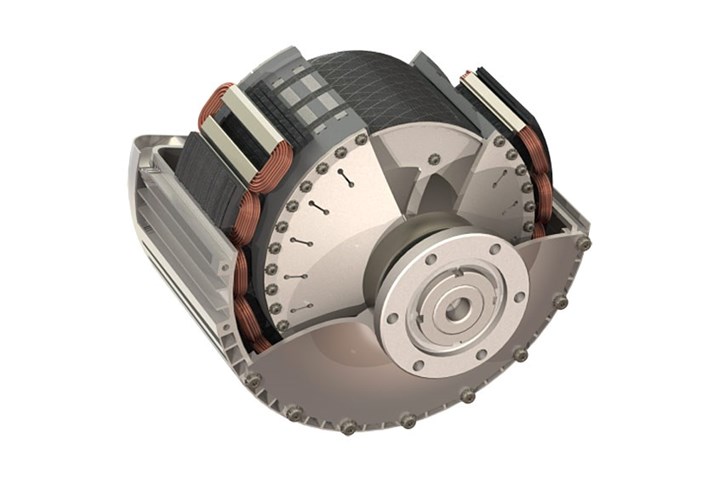Magnomatics designs air-cooled propulsion motor for UAM
Carbon ThreeSixty will be evaluating composite materials use to further reduce weight and increase torque for the 86-kilowatt magnetic gear motor.

Magnomatics' lightweight, air-cooled propulsion motor. Photo Credit: Magnomatics
Magnetic gear technology company Magnomatics Ltd. (Sheffield, U.K.) has designed a lightweight, air-cooled propulsion motor suitable for the rapidly growing urban air mobility (UAM) sector. The 86-kilowatt motor with a torque density of 30 newton-meters per kilogram (Nm/kg) will, it says, challenge other established motors in the market.
The company has recently started a NATEP (National Aerospace Technology Exploitation Programme) grant-funded project to investigate further light-weighting of this motor and is collaborating with Carbon ThreeSixty (Chippenham, U.K.) to see how composite materials can be used to further reduce the mass and potentially enhance performance to provide an increase in torque density to greater than 30 Nm/kg. The motor will be manufactured and tested to meet DO-160G specifications.
NASA (Washington, D.C., U.S.) has identified magnetic gears as being a potential technology for electric aircraft. In 2018, it embarked on a two-and-half-year program described in the paper “Magnetic Gearing Research for Electrified Aircraft Propulsion.” NASA’s original focus was on pure magnetic gears but in the 2020 paper, “Outer Stator Magnetically Geared Motors for Urban Air Mobility Vehicles,” they concluded that the concentric combination of a magnetic gear and a permanent magnet motor would be ideal for an electric vertical takeoff and landing (eVTOL) UAM aircraft.
Magnomatics spun out of the University of Sheffield in 2006 to commercialize this technology based on magnetic gears. Among its patented products is the pseudo direct drive (PDD), which is an outer stator magnetically geared motor (OMSGM). The first commercial priorities for the PDD were for relatively large machines for applications such as wind power, marine propulsion and rail. In 2019, Magnomatics built and tested the largest PDD to date, with a 200,000 newton-meter rating. This was subsequently tested at the Offshore Renewable Energy Catapult at Blyth in the U.K.. Based on the results, a large global engineering company is now evaluating the PDD technology for a number of sectors.
The UAM motor designed is based upon PDD technology, identified by NASA as being “roughly two times greater than the specific torque expected of a direct drive electric motor for the same application.”
Magnomatics says that key features of the motor include: Highest continuous torque density; less than 60% size and mass of a PM machine; high efficiency; fault tolerance; built-in passive torque fuse (protecting drivetrain); low maintenance; and high reliability.
“We are delighted to receive support from NATEP for this project. The market for eVTOL motors for UAM is forecast to be substantial and we believe we can provide motors that will deliver a significant advantage,” David Latimer, CEO of Magnomatics, says. “Our long-term intention is to manufacture these motors here in Sheffield. A contribution not just to leveling up, but also to achieving net zero.”
Related Content
-
One-piece, one-shot, 17-meter wing spar for high-rate aircraft manufacture
GKN Aerospace has spent the last five years developing materials strategies and resin transfer molding (RTM) for an aircraft trailing edge wing spar for the Airbus Wing of Tomorrow program.
-
A new era for ceramic matrix composites
CMC is expanding, with new fiber production in Europe, faster processes and higher temperature materials enabling applications for industry, hypersonics and New Space.
-
Plant tour: Spirit AeroSystems, Belfast, Northern Ireland, U.K.
Purpose-built facility employs resin transfer infusion (RTI) and assembly technology to manufacture today’s composite A220 wings, and prepares for future new programs and production ramp-ups.
















